The ‘2021 State of Food Security & Nutrition in the World’ report’ estimates that around 2.37 billion people did not have access to adequate food during 2020, which is approximately 1/3rd of the global population. The report also estimates that around 720-811 million people in the world faced hunger in 2020.
COVID-19 pandemic had a severe global impact and continues to affect various walks of life. The measures taken by countries to control the spread of infection through lockdowns, quarantines, curfews, etc. have caused a disruption to human & economic activities. Loss of lives & livelihoods, an increase of financial burden, etc. are a direct result of the impact on the economy, that has further pushed marginalized communities into poverty & hunger. The ‘2020 State of Food Security & Nutrition in the Word’ report estimated that the COVID-19 pandemic could push an additional 83 million -132 million into chronic hunger in 2020.
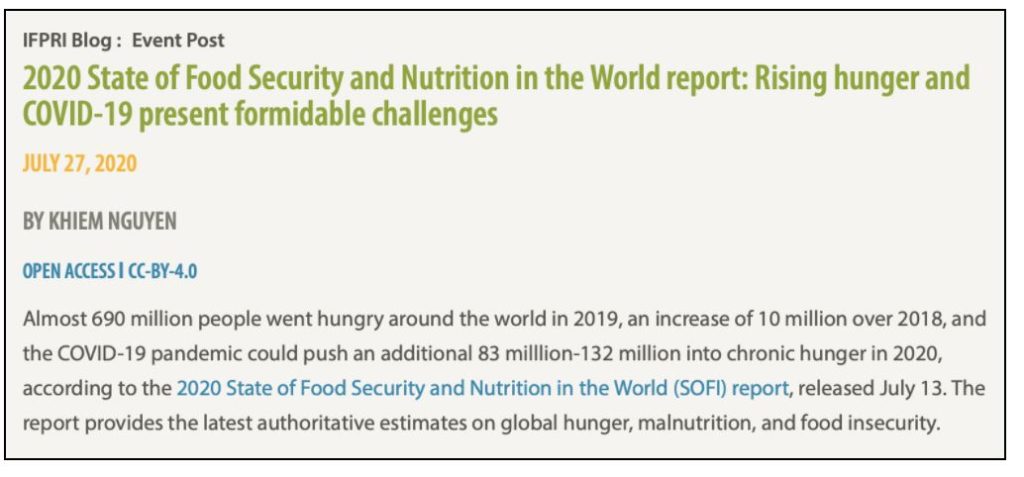
The ‘2021 State of Food Security & Nutrition in the World’ report (SOFI 2021) released on 12 July 2021, provides details on the impact of COVID-19 on food security in the world based on real-time global COVID-19 experience in 2020. In this story, we look at the trends related to ‘Global Food Security & Nutrition’, the initiatives taken by various countries to handle challenges of food security during the pandemic, with a focus on India.
Around 118 million more people are undernourished in 2020
The SOFI 2021 report estimates that around 2.37 billion people did not have access to adequate food during 2020. This is approximately 1/3rd of the global population. There is an increase of 320 million people in 2020 alone, who did not have access to adequate food during the year.
While the impact of the COVID-19 pandemic in 2020 is yet to be fully quantified, SOFI-2021 estimates that around 720-811 million people in the world have faced hunger in 2020. Considering the middle of the projected range it is around 768 million people. In other words, 118 million more people faced hunger in 2020 compared to 2019. (161 million if the upper limit is considered). Since 2018, there has been a gradual increase in the number of people facing hunger, but the increase is steep in 2020.
The Prevalence of Undernourishment (PoU) has increased to 9.9 % compared to 8.4 % in 2019. PoU is the percentage of the population whose consumption falls below MDER (Minimum Dietary Energy Requirement). PoU is one of the indicators for Sustainable Development Goals (SDG 2.1.1). The estimated steep increase in PoU in 2020 may influence the progress towards achieving the SDG target of ending hunger by 2030.
While the impact is spread across the regions, around 100 million more are affected by hunger in Asia & Africa in 2020
The increase in the number of people who faced hunger in 2020 is across all the regions around the globe. For the first time since the FIES (Food Insecurity Experience Scale) Data is available i.e., 2014, ‘Food Insecurity’ has increased in North America & Europe. These two continents have most of the developed countries in the world. The rise of Food insecurity in even these continents is a reflection of the hunger situation influenced by COVID-19.
Around half of the undernourished population of the world in 2020 are in Asia, while Africa accounts for 1/3rd of the undernourished population in the world. It is estimated that Latin America & Caribbean region has around 60 million of the undernourished population in the world.
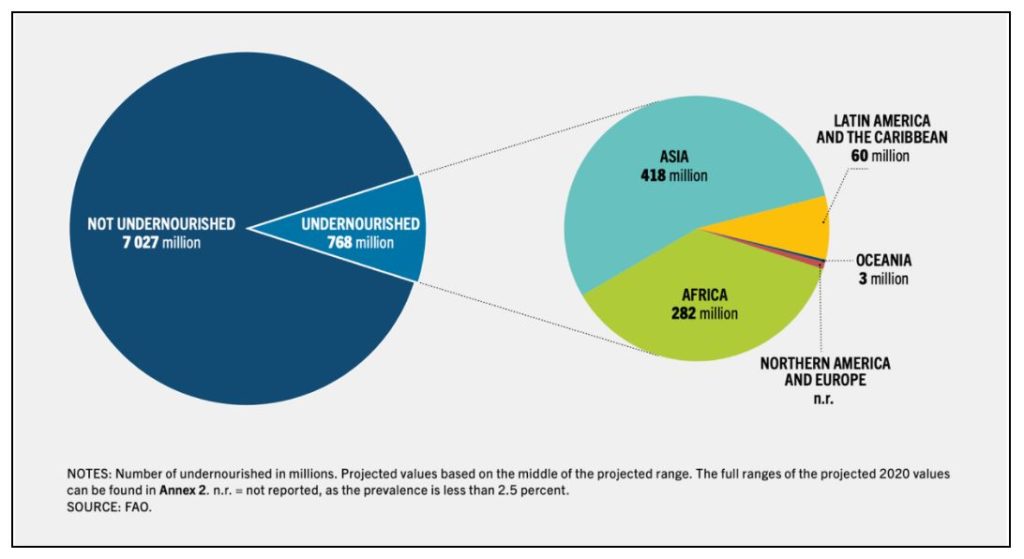
However, in terms of the proportion of the population, Africa has a higher proportion of its population facing hunger in 2020.
- During 2020, hunger has affected 21% of Africa’s population whereas, in Asia and Latin America & Caribbean, hunger affected 9% and 9.1% of the population respectively.
- The steepest increase in food insecurity during 2020 was observed in Latin America & the Caribbean. The PoU in Africa increased from 18% in 2019 to 21% in 2020 while in Latin America & the Caribbean it increased from 7.1% to 9.1%.
- Sub-Saharan Africa, Central America & South America are the major contributors towards the increase in hunger levels among the world population.
- In Africa, the PoU went up to the levels of 2005 when it was 21.3%. So is the case with Latin America.
- The increase is less steep in Asia with a 1.1% increase in PoU during 2020 compared to 2019. However, there is an increase of 2.5% in South Asia.
- The PoU in North America, Europe & Oceania largely remained unchanged.
While there is a slight increase in the absolute numbers, the stability of PoU in North America, Europe & Oceania indicates their economic stability in providing Food security even during a global pandemic. While on the other end, the steep increase in Africa & Latin America shows the vulnerability of the population living in such impoverished & poor countries.
The concerning factor in the case of Africa is the increase in the ‘Severe’ food insecurity category in 2020. The ‘Food Insecurity’ is categorized as ‘Moderate’ & ‘Severe’. In the case of Asia, the increase in Food Security is mostly in the case of ‘Moderate’ whereas, in Africa, those at a severe level of Food insecurity increased from 21.9% to 25.9%. Latin America has seen an increase in both levels during 2020.
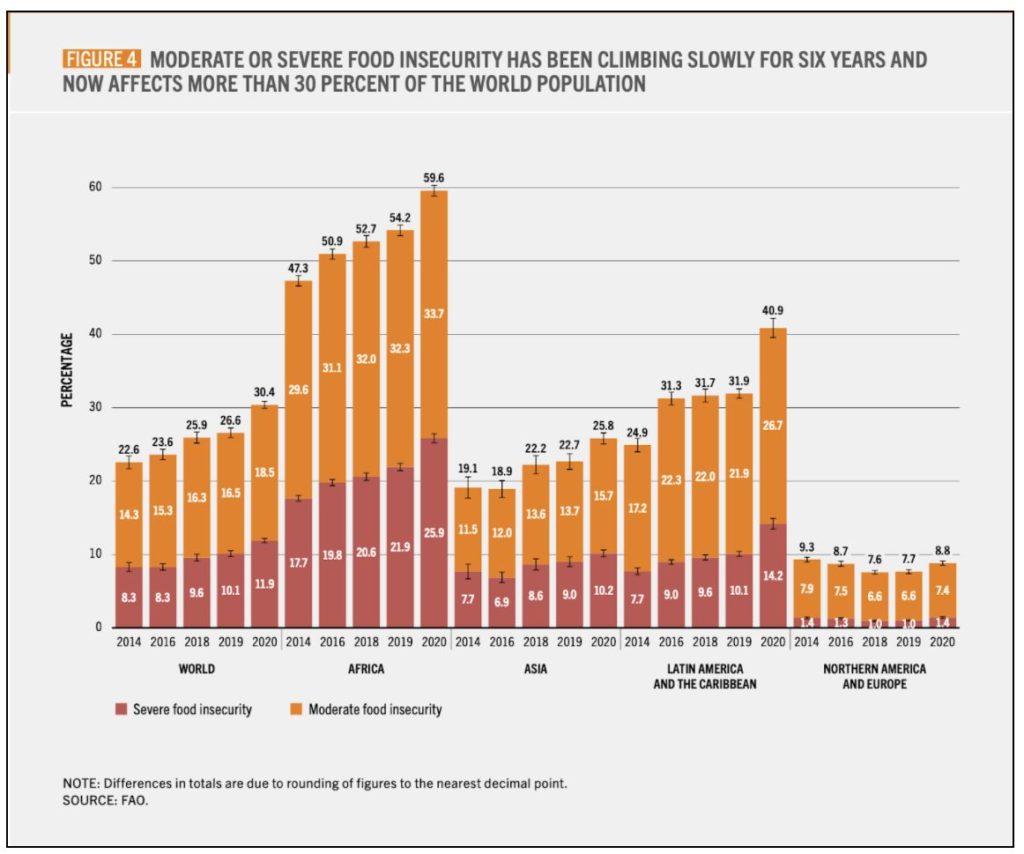
Various factors influenced the rise in ‘Food Insecurity’, now exacerbated by COVID-19
SOFI-2021 report observes that the COVID-19 pandemic has been a key factor driving the increase in food insecurity across the globe. However, this increase cannot only be attributed to the pandemic since there are other factors also which are at play. The report observes that the pandemic-induced economic hardships have aggravated the existing inequalities in access to food. As per World Bank estimates, around 119-124 million people were pushed into extreme poverty in 2020.
The report further quotes other World Bank surveys that point to a decrease in income across both urban & rural households due to the COVID-19 crisis. This fall in incomes has a direct impact on the access to food, and importantly affordability of nutritional diet. Apart from economic slow-downs & downturns, conflict, climate variability & extremes are other factors that have an influence on mitigating hunger & malnutrition.
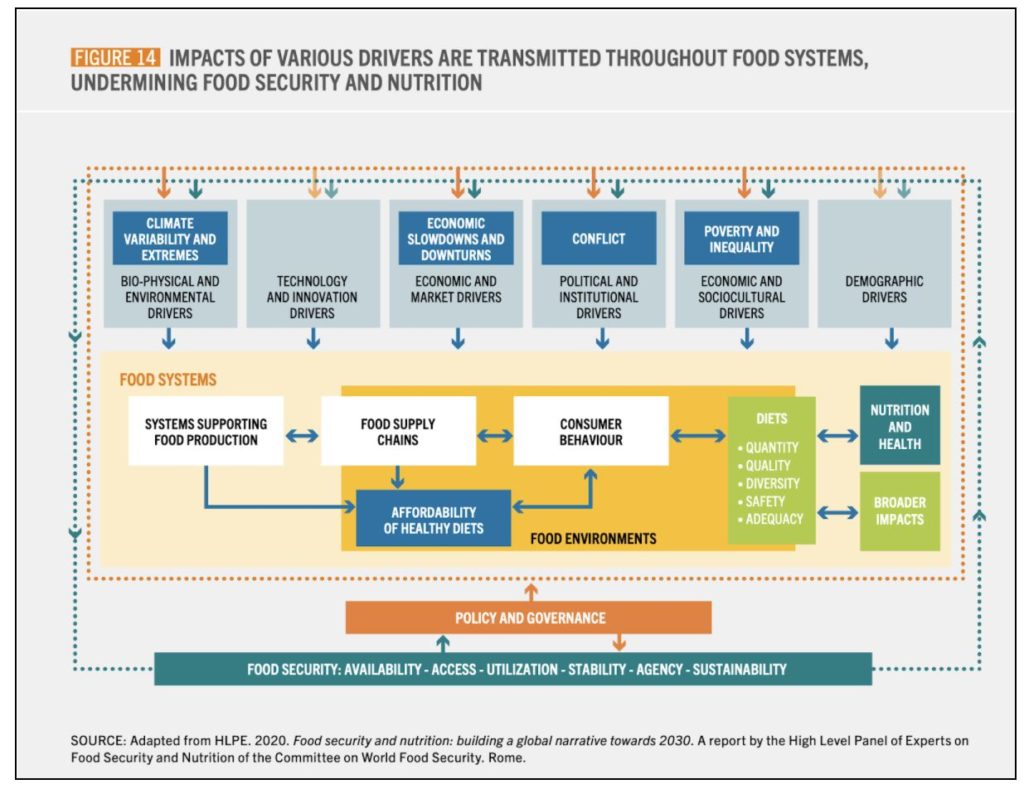
The report observes that the COVID-19 pandemic had an impact on each of the drivers of food systems, thereby aggravating food insecurity. It highlights that the measures taken by governments to counter COVID-19 spread have dealt devastating blows to global food security & nutrition.
- Such measures have resulted in an urgent humanitarian crisis in 55 countries. The Economic shocks were the key drivers towards food security in 17 of these countries and impacted around 40 million people. In 2019, there were 8 countries that had food insecurity due to economic shocks.
- While the food supply chains have been robust than expected the capacity of people to purchase food has reduced. Particularly, those employed in informal sectors have witnessed a major impact on their incomes. However, in highly developed countries, the governments came to the rescue by providing support to employers in retaining the employees further highlighting the difference of response between high-income & less-income countries.
- The supply-side of Food systems has been impacted by border closures, travel restrictions, quarantines, etc. These disruptions to the supply chains have limited access to nutritious food.
Apart from the factors triggered by the COVID-19 pandemic, climatic & environmental factors also had an impact on the food security across the countries.
- Locusts’ outbreaks in East Africa & South Asia
- Hurricanes Eta & Iota requiring emergency response due to acute food insecurity in Central American countries.
- Droughts, cyclones & seasonal flooding in South Sudan & the Democratic Republic of Congo.
A combination of these factors had an influence on Food security across the countries.

Estimates for 2021 indicate that all these factors along with COVID-19 have been instrumental in several countries facing food insecurity situations. The number of countries pushed into food insecurity increased because of each of these factors.
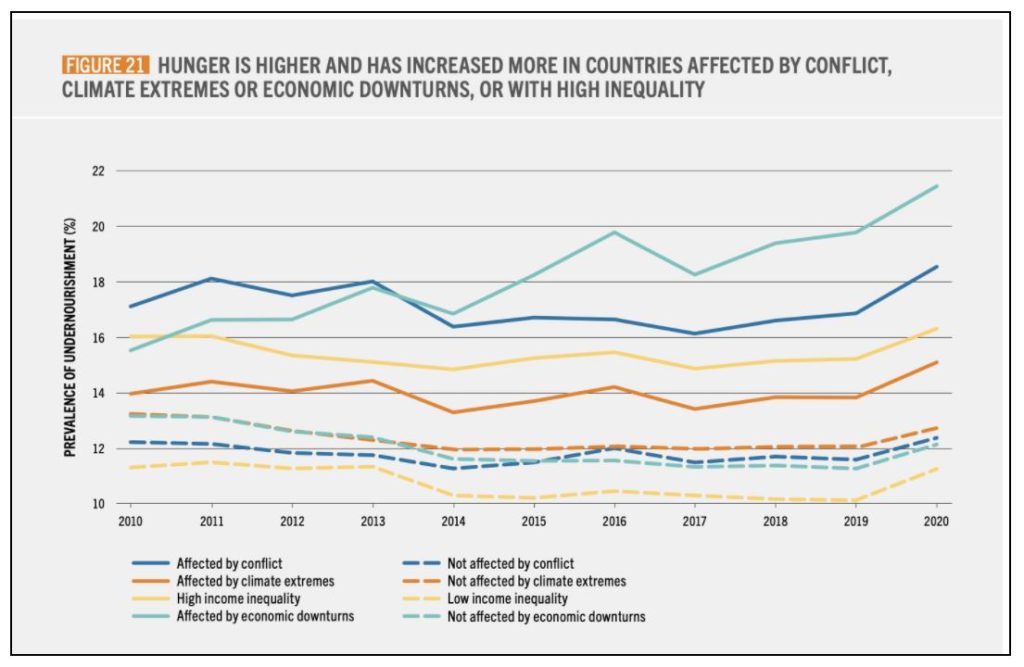
Continued assistance by Governments’ key in ensuring ‘Food Security’ in respective countries
SOFI-2021 report observes that there has been an unprecedented response by respective governments worldwide to implement social protection measures. However, the speed of implementation, coverage, duration of the social protection responses has varied across regions and countries. This has resulted in varied effectiveness of these measures in addressing poverty & food insecurity during the pandemic.
The report also highlights certain studies which stated that a majority of the assistance programs are short-lived with the average support lasting just over 3 months. Around 40 % of the programs consisted of one-time payments.
India has reported the second-highest number of COVID-19 cases and the impact of the pandemic is multifold. The nationwide lockdown at the beginning of the first wave between March & May 2020, and the varying levels of restrictive measures by States during the second wave between April & May 2021, have resulted in an immense strain on the economy of the country leading to job losses, loss of income, etc.
The Union government & the respective State governments have responded by providing assistance in various forms. Many such measures announced by the government were highlighted in our earlier stories. The measures include:
- Supply of free food grains under Public Distribution System (PDS) from April to November 2020.
- Increased rural employment under MGNREGA.
- Cash transfers to old-age pensioners & women
Responding to a question in the Lok Sabha, the government reiterated the measures taken by the Union government to ensure food security during the COVID-19 crisis under Pradhan Mantri Garib Kalyan Yojana (PMGKY) & Atma Nirbhar Bharat Program.
Under PMGKY, additional 5 kgs of food grains per person per month were provided under ‘Targeted PDS’ to around 80 crore persons. As per the government’s response, the migrants stranded between the States were provided 5 kgs of food grains per person per month for May & June 2020. The assistance provided during COVID-19 is beyond the food security extended by the government as part of NFSA -2013 (National Food Security Act-2013).
In another response provided in Lok Sabha on 09 February 2021, the Union Government highlighted the impact of NFSA in ensuring Food security in the country.
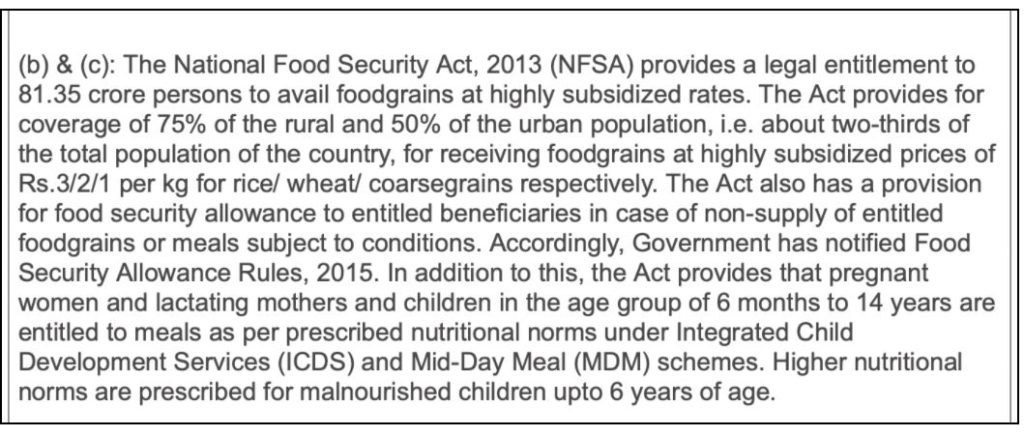
The SOFI-2021 report and the data available with FAO (Food & Agricultural Organization) provides the country-wise data for 2020, to understand the impact on food security during the pandemic. As per the available data, the prevalence of undernourishment in India was 15.3% during 2018-20 compared to 21.6% in 2004-06. This indicates that initiatives like NFSA have been effective to an extent in providing food security.
However, as highlighted earlier, South Asia has been the major contributor to the increase in PoU in Asia during 2020 compared to 2019, when it increased from 13.3% in 2019 to 15.8% in 2020.
To deal with the second wave of COVID-19 in the country, the Union government approved the allocation of free foodgrains for a period of 5 months (July to November 2021) at 5 kg per person per month for about 81 crore beneficiaries.
Featured Image: 2021 State of Food Security & Nutrition in the World Report


